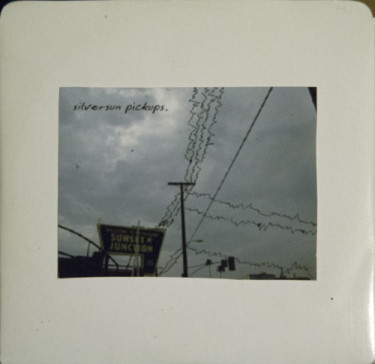
Nikki Monninger (bass and sometimes-vocals), Chris Guanlao (drums)
Stop the season, stop the sting
The members of Silversun Pickups were not new in town when they released their first EP. In fact, all four had been veterans of the Silver Lake, L.A. music scene, the same scene that produced Beck, Rilo Kiley, Autolux, Elliott Smith, and tons of other scrappy rock groups. The Pickups would soon join their ranks.
A loose collective, known as The Ship, had formed in the scene, including the former bands of all four members of the Pickups. "We were just friends for so long, it was kind of an accidental collective," Brian recalled. "There was never a mission statement. We're just friends and we play in each other's bands."
The band was started after Nikki decided to take up bass and Brian's then-girlfriend, Elvira, decided to take up drumming. The origins of the band could be traced back to a shoddy boombox tape recorded during a jam session in the summer of 2000. An early version of "Kissing Families" and an early "Lazy Eye" could be heard on it. For fun, the group decided to send it to the CMJ Music Marathon, a festival in New York for new, emerging bands. They scribbled down a bio about their cat and sent the tape off.
They didn't actually expect to get in.
With no plan and no practice, the band quickly cobbled together six loose song ideas, shipped off to New York City, and played their set. Afterwards, Mitchell Frank, the man who owned the Los Angeles-based Spaceland (now called The Satellite), offered the band a gig on the basis that they frequented his club. They took it, and were immediately offered another by Scott Sterling, who owns the Silverlake Lounge, another club in the area. The offers kept coming; much of the band's early approach can be traced back to the trial-by-fire nature of the stage being their practice space.

The thought of actually recording their material came up when Brian discovered some rather cooked-sounding bootlegs of the band's live set floating about. "I listened to one and it was so, so bad," he said. "If people are willing to listen to that, then we should probably start recording." Thankfully, their friends in Earlimart ran a studio, also named The Ship, where other bands in the collective often recorded. In fact, the first recording the band had ever released was a split 7" on Sea Level Records (Sea Level being a now-defunct record store in Silver Lake) with another Ship group, Pine Marten.
By late 2002, Elvira jumped ship and Chris had taken her place. Jack Kennedy, the band's original rhythm guitarist, stuck around for a little longer, but was soon dropped for (in the words of his own press release) setting Brian's sweater on fire. The band would soon scoop up their final proper member, mad scientist keyboards-and-samplers guy Joe, in 2003, after Pine Marten dissolved and their other members went to play keys for the Radar Bros. Finally, the lineup had solidified.
The band credits a specific show with solidifying their sonic identity: prominent indie soulbarer Elliott Smith, who were friends of the band, asked them and Rilo Kiley to open for him on one of his sold-out comeback shows at the Henry Fonda Theater in Hollywood in February 2003. The formerly shy, rough-edged band came off the stage confident and ready to move beyond the small clubs and house parties that birthed them.
Around 2004, a new label sprouted up in the Silver Lake area. Eager to begin promoting the exciting indie rock scene there, Dangerbird Records snapped the band up and released Pikul in 2005. Named for a fallen friend, the EP featured recordings dating back from 2002 ("...All the Go Inbetweens", when Elvira was still in the band) to the then-present, with three songs being recorded specifically for its release. The artwork had even been based on one of their earlier, self-titled demos.
Reaction to the EP was quite positive, getting play on more adventurous stations like Seattle's KEXP and increasing the band's national profile. Many wondered what the Pickups would do next. The answer was Carnavas.
Back to topA time, a place, a whole industry
The Pickups wanted to keep Pikul its own distinct entity from their upcoming full-length. Whereas Pikul was airy, loose, scrappy, and organic, the full-length was to be an electrical storm that represented their live sound. They called it Carnavas, a reference to Brian's Greek heritage. As he put it, "Carnavas is in homage to a side of my family that will soon be extinct—it's their maiden name, it's Greek. So it's another kinda sad homage, but in the same respect, it's another totally pretentious word, so people can make up their own ideas."
The band stepped into Sunset Sound in 2005, breaking out songs from all throughout their Pikul days. Many were rearranged. The result became the group's true introduction to the world. Live 105, a radio station in the San Francisco area, saw potential in their signature song, "Lazy Eye", and put it into heavy rotation. It didn't take long for things to fall into place, and the band began to tour heavily, supporting bands such as Wolfmother, OK Go, Snow Patrol, and the Kaiser Chiefs.

The sudden worldwide exposure and tour took its toll on the band, who came back to Silver Lake to find themselves strangers. "It was a dark time when we got back," Brian said in interviews at the time. "We had to water the relationships that we had neglected over those two years." The Pickups began to be compared heavily to the Smashing Pumpkins, thanks to the fuzzy guitarscapes of both bands. Sometimes, the comparisons would devolve to the outlandish: both bands featured a girl bassist who sang, or both bands featured an Asian-American, enough for lazy journalists to dismiss them.
The group began to prepare songs for a follow-up. This would be the group's first set of songs written specifically for an album, as Pikul and Carnavas were built from songs from the group's early repertoire. The stress of a sophomore album influenced the record's heavier, darker sound. The story goes, the first day of writing, Brian wrote the word "swoon" on a whiteboard. Alternatively gloomy and romantic, much like the word, the record would be named Swoon and released in mid-2009.
Back to topNo need to fight it, 'cause you're giving in
Swoon brought the band a second wind on the power of one single in particular, "Panic Switch". A six-minute nervous breakdown, "Panic Switch" was actually written towards the very end of rehearsals, almost as an afterthought. The success of the track was bolstered by the other singles from the record, and while critics continued to either appreciate the band's neo-90s aesthetic or deride them based on the Smashing Pumpkins comparisons, Swoon did very well indeed.

The record also saw the group's sound evolving subtly. Gone were the freeform walls of feedback found on their early demos and Carnavas; riffs were at the forefront of this one. "Substitution" hinted at the band's indie rock roots, while "The Royal We" and "Catch and Release" proved they hadn't forgotten about the strings that once hugged the edges of "Kissing Families". B-sides trickled out on later releases, such as 2011's Seasick, which featured three tracks from the Swoon sessions.
By this point, the Pickups were very well known for their energetic stage shows (indeed, they found their way onto the Coachella bill sometime around here), but 2009 found their attack blunted somewhat by a surprise MTV Unplugged performance. Between another set of tour dates with Muse, Placebo, and Against Me!, the band had been looking to shift their approach for their next record. They figured the best way to do so would be to record with a producer who wasn't named Dave Cooley.
Through the band Bloc Party, the band discovered Jacknife Lee, known for recording groups such as U2, R.E.M., Weezer, and The Hives. His clean, precise approach stood in opposition to the band's organic mess of fuzz, but they took him on nonetheless.
Jacknife would push the band to focus on melody more than atmosphere and rethink their entire process. Joe described it as such in a 2012 interview: "It was like, "Well, does it have to go like this? Does it have to do this?" We ended up fighting for why a song needs to be exactly the way it is. He'd be like, "Oh, you know what? The bridge would be better as the verse." There were a couple songs that were deconstructed completely and built back up in a completely different way."
The result of their experimentation was 2012's Neck of the Woods.
Back to topI can never show you what you gave to me
Neck of the Woods showed a radically different direction for the band. While the soundscapes and guitars remained, one was no longer predicated on the other. Instead, Joe's synths and the war between Chris' drums and drum machines took center stage. At nearly an hour long, Neck of the Woods showed the band had no intention of compromising the cinematic sprawl of their previous records.

Perhaps the sound of the record is best encapsulated by the change in cover art. Gone were the abstract Darren Waterston paintings, swirling and bubbling as did the guitar fuzz on Carnavas and Swoon. In their place lay a stark image of a house in the middle of nowhere, the lights still on inside, with the sky a dreary grey-green overhead. This is roughly what Neck of the Woods sounds like.
The lead single off the album, "Bloody Mary (Nerve Endings)", once again propelled the record's success. Over percolating synths and IMAX-sized production lay the record's central themes of horror and dread. Where Swoon was timid and socially awkward, Neck of the Woods played to more primal fears, one of quarantine, insanity, fatigue, and paranoia. Nowhere is this more apparent than the seven-minute "Simmer", with its whispers of sirens, chattering vents, and fights that never end that pile up on the chamber floor before the song comes to a buzzing simmer, fittingly.
Things were not well on the live front, however. The group didn't play a single date outside of North America on the Neck of the Woods tour, and Nikki would temporarily split from the group to nurse newly-born twins. Sarah Negahdari, on loan from The Happy Hollows, filled her spot on tour.
2013 and 2014 brought two supplemental releases to the Silversun catalog, the 10" Let it Decay/Working Title and the dual digital and vinyl boxset The Singles Collection. The latter brought a newly cut track, "Cannibal" (and the Swoon b-side "Devil's Cup", for a vinyl exclusive), and the news that it would be the final release for the group on Dangerbird Records, which had fostered them since Pikul.
Silversun Pickups were eager to go fully independent for album four, and established their own label, New Machine Recordings (named after a line in "...All the Go Inbetweens") to do so. Stepping back into the Topanga-based studio of Jacknife Lee, the band would continue their new trajectory, and the orange glow of Better Nature would soon surface.
Back to topWhen you seal it away and you're on your own

Better Nature continued to find the band in new sonic territory. While their thirst for grandiose arrangements was still there, there was more an emphasis on a warmer, more pop-friendly sound. Nikki would get her first lead vocals spot since "Ribbons & Detours" on "Circadian Rhythm (Last Dance)", Joe and Chris would step up for some of the gang vocals on lead single "Nightlight", and more acoustic instrumentation, such as vibraphones and acoustic basses, would show up in the mix.
Silversun visually reinvented themselves for the new sound once again. Rebekkah Drake, Joe's wife, conceived of the "paintball in the desert" motif to go with the themes of the record, that of the Californian drought and celebrating through the apocalypse. All across the album's promotional art were splotches of paint and streaks of colorful smoke, once again a detour off the skeletal, barren art for Neck of the Woods.
2017 saw the band slow down, but not necessarily grow any less busy. Their music was heavily featured in Axis, a film directed by Aisha Tyler, who directed the semi-official "Simmer" video. Not to mention more festivals, more live dates, more tours overseas—how fitting that the band forged on the firey stages of Los Angeles clubs is still going at it strong, all these years later.
As history would have it, after two albums with Jacknife, it was time to switch producers. After becoming fast friends with the band Garbage (and after Brian made a vocal appearance on that band's 2015 single "The Chemicals"), the band took drummer Butch Vig on as producer, best known for his work with Nirvana and the Smashing Pumpkins in the early 90s. 2019's Widow's Weeds would signal something of a switch in mindset and sound for the aging band.
Back to topI need a fresh start now, reboot the machine

As came out during the press for Widow's Weeds (named for the black clothes of Victorian widows), much of the interrim between albums was spent in struggle: Brian sought treatment for his alcoholism and Joe's father died. Rather than create an album of misery, they instead chose to create an album of change, of flux.
Certainly, much of the songwriting bears out the press: Widow's Weeds was as focused and direct as the group got, with the record lasting a relatively brisk (by Pickups standards!) 47 minutes and some tracks barely reaching three minutes. The fuzz was still mostly gone, but so was Jacknife's mechanical, vacuum-sealed production. Butch instead let the proceedings breathe, notable on more low-key tracks like the title track and "Bag of Bones". On the flipside, Swoon's huge string sections made a return on songs like "Straw Man" and "Freakazoid", a welcome return indeed.
Visually, Widow's Weeds signaled another change for the band, with the roots on the cover looking more like veins and the band wearing solid colors against white backdrops in press photos and in the video for lead single "It Doesn't Matter Why". Already, the band's followed it up with another round of touring, bless them, and if I might be biased, having seen them on the album's tour, they've very much still got it.
Only time will tell where this group of old friends and monster musicians will go next. Stay tuned.
Back to top